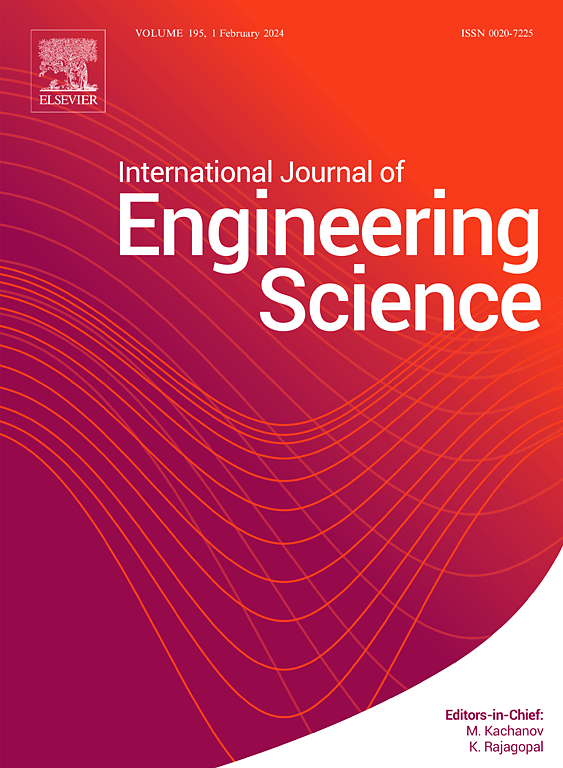采用实验设计方法对六路结微流控装置中双乳液滴的生成进行了数值研究
IF 5.7
1区 工程技术
Q1 ENGINEERING, MULTIDISCIPLINARY
International Journal of Engineering Science
Pub Date : 2025-10-09
DOI:10.1016/j.ijengsci.2025.104393
引用次数: 0
摘要
本研究采用基于流体体积-连续体表面力(VOF-CSF)方法的数值模拟研究了六路结微流控装置中双乳液滴的受控生成。利用实验设计(DOE)和响应面法(RSM)在流动聚焦微流控装置中,首次研究了内相毛细管数和相流量等重要参数对双乳特性(包括微滴尺寸、壳层厚度、复合微滴产生频率和单分散性)的同时影响。根据我们的研究结果,决定双乳特性的最重要参数是外相流量。当内相毛细管数和中相流量增大,外相流量减小时,也会产生多芯双乳液滴。此外,我们还表明,在输入参数范围内,双乳液在滴注和喷射流动模式下的单分散性在大多数应用中是可以接受的。该研究超越了传统的液滴生成技术,通过确定最佳流动组合,并提供定量方程,以精确预测和控制基于输入参数同时影响的双乳特性。此外,所提出的模型使生成具有宽范围的壳厚度和不同数量的内部液滴的多个双乳成为可能。该研究结果为设计微流体系统提供了一种创新的方法,该方法已成功地用于双乳液生成,特别是在复杂的封装系统以及食品和制药工业中。本文章由计算机程序翻译,如有差异,请以英文原文为准。
Numerical study and controlled generation of double emulsion droplet in a six-way junction microfluidic device using design of experiment method
This study uses numerical simulations based on the Volume of Fluid-Continuum Surface Force (VOF-CSF) method to investigate the controlled generation of double emulsion droplets in a six-way junction microfluidic device. Using Design of Experiments (DOE) and Response Surface Methodology (RSM) in a flow-focusing microfluidic device, the simultaneous effects of important parameters, including the inner phase capillary number and phase flow rates, on the double emulsion characteristics, including droplet size, shell thickness, frequency of compound droplet generation, and monodispersity are investigated for the first time. According to our findings, the most significant parameter determining the double emulsion characteristics is the outer phase flow rate. Multi-core double emulsion droplets are also generated when the inner phase capillary number and middle phase flow rate increases and outer phase flow rate decreases. Additionally, we show that the monodispersity of the double emulsion under the dripping and jetting flow patterns is acceptable for most of the applications within the range of input parameters. This research develops beyond conventional droplet generation techniques by identifying the optimal flow combinations and providing quantitative equations for precisely predicting and controlling double emulsion characteristics based on the simultaneous effects of input parameters. Additionally, the proposed model enables it possible to generate multiple double emulsions with a wide range of shell thicknesses and different numbers of internal drops. The findings provide an innovative approach for designing microfluidic systems that have been successfully used in the double emulsions generation, especially in complicated encapsulation systems and for the food and pharmaceutical industries.
求助全文
通过发布文献求助,成功后即可免费获取论文全文。
去求助
来源期刊

International Journal of Engineering Science
工程技术-工程:综合
CiteScore
11.80
自引率
16.70%
发文量
86
审稿时长
45 days
期刊介绍:
The International Journal of Engineering Science is not limited to a specific aspect of science and engineering but is instead devoted to a wide range of subfields in the engineering sciences. While it encourages a broad spectrum of contribution in the engineering sciences, its core interest lies in issues concerning material modeling and response. Articles of interdisciplinary nature are particularly welcome.
The primary goal of the new editors is to maintain high quality of publications. There will be a commitment to expediting the time taken for the publication of the papers. The articles that are sent for reviews will have names of the authors deleted with a view towards enhancing the objectivity and fairness of the review process.
Articles that are devoted to the purely mathematical aspects without a discussion of the physical implications of the results or the consideration of specific examples are discouraged. Articles concerning material science should not be limited merely to a description and recording of observations but should contain theoretical or quantitative discussion of the results.
 求助内容:
求助内容: 应助结果提醒方式:
应助结果提醒方式:


